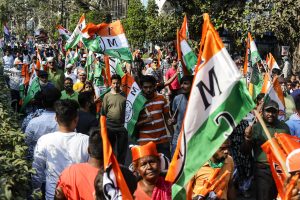With just two of the eight phases left to go in the West Bengal state assembly elections, the two frontrunners, the Trinamool Congress (TMC), a regional party that has ruled West Bengal since 2011, and its main challenger, the Hindu nationalist Bharatiya Janata Party (BJP), which heads India’s federal government, have stepped up their campaigns.
So far, the campaigns of these parties have essentially involved attacks on each other’s leaders.
Addressing a public rally on April 19, TMC leader and West Bengal Chief Minister Mamata Banerjee said that Prime Minister Narendra Modi is responsible for the “skyrocketing” COVID-19 cases in India. “He is the man who is responsible. No planning, no administrative capabilities, complete inefficiency,” she said.
Although this is a state assembly election, Modi is a star campaigner of the BJP and has addressed dozens of rallies in the state.
India is grappling with a huge second wave of COVID-19. On April 20, it reported an unprecedented 294,291 new daily infections. West Bengal, meanwhile, registered its highest daily spike of 9,819 new cases that day.
Yet political parties have been holding massive rallies and roadshows that are attended by tens of thousands of people. Neither leaders nor supporters wear masks or maintain social distancing norms at these events.
Although the Election Commission has restricted campaigning hours at night, this is hardly the tough response needed to cut the crowding during the campaigning.
On April 19, the opposition Congress announced that it was halting all rallies across West Bengal. The TMC responded soon after, albeit half-heartedly. It will be holding small meetings in Kolkata. The last to respond was the BJP. Only after its rivals downsized their campaigns did it agree to restrict participation at its elections rallies.
So important is the Battle for Bengal that the two main parties in the fray are reluctant to draw down their campaign in the final stages, despite the pandemic.
The TMC has projected itself as a party representing Bengali pride and criticizes the BJP as a party of “outsiders,” which polarizes society along communal lines. As for the BJP, it has accused the TMC of being anti-Hindu and appeasing Muslims. It has also alleged that the TMC government has prevented Bengal from benefiting from the BJP-led federal government’s development policies and programs.
The fight has become increasingly personal and nasty. Politicians’ speeches are aimed more at belittling each other rather than highlighting their plans for Bengal. They are peppered with personal insults and attacks.
Banerjee, for instance, has engaged in much name calling. She describes Modi as a “liar” and a “rioter.” “Something is wrong with his brain,” she said at a rally, adding that “it seems his screw is loose” (meaning he is of unsound mind).
As for Modi, he has repeatedly mocked Banerjee. Banerjee is generally referred to as didi or elder sister in West Bengal, but Modi uses the word “didi” in his speeches in a way that is disrespectful; the tone that he adopts seems like a catcall.
Of the four states and one union territory that have been voting in assembly elections since March 29, it is West Bengal that that the BJP covets the most. The party has never ruled Bengal; indeed, BJP candidates have rarely won in the state.
The BJP is hoping to change that in this election. It is pulling out all the stops to ensure an improved tally if not outright victory. It has not hesitated to use state machinery to its advantage.
The party has deployed its entire top brass, including ministers in the federal government like Modi and Home Minister Amit Shah to campaign for its candidates in West Bengal.
West Bengal has never embraced the BJP. The state was a Communist bastion for 34 years and since 2011, the TMC has been in power.
The state elected its first BJP member of parliament only in 1998. The party entered the West Bengal assembly for the first time only in 2016. That year it won three seats in the 294-seat House.
Support for the BJP in Bengal has grown remarkably in the years since. In the 2019 parliamentary elections, the party won 18 of the 42 seats from West Bengal. It cornered 40.64 percent of the votes, just 3 percentage points less than the TMC’s vote share.
With the BJP snapping at its heels, the TMC is worried now.
Getting the most seats isn’t enough; it has to win a majority. Otherwise it will have to turn to the Left-Congress-Indian Secular Front alliance for support to keep the BJP out of power in the state.
The BJP is eyeing power. But securing any number of seats more than the three it held in the outgoing assembly would be accomplishment enough.
The implications of the current elections go way beyond West Bengal. Should the TMC hold Fortress Bengal and keep out the BJP, Banerjee stands a good chance of leading the opposition alliance against the BJP in general elections-2024.

































